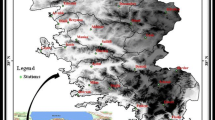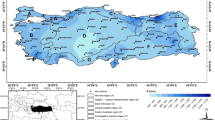Abstract
This paper focuses on spatiotemporal characteristics of precipitation indices of Turkey’s precipitation data for the periods 1966–2014. Seven precipitation indices include the number of extremely wet days, very wet days, heavy precipitation days (10 mm and 20 mm), simple daily intensity days, and consecutive dry and wet days. The indices are based on homogenized precipitation data. Besides, long-term changes and trends in the time series of precipitation indices in terms of climatic variability were investigated using nonparametric time series analysis methods. The results obtained are summarized as follows. Extremely wet and very wet day indices include significant decreasing trends in most stations. The trend is statistically significant at some stations in the Mediterranean region and southeastern Anatolia region. The number of heavy precipitation day indices tend to decrease in most of the stations in the Mediterranean precipitation zone, throughout Turkey. Simple daily intensity index generally displays an increasing trend. Consecutive dry days include an overall upward trend throughout Turkey. The inner and in the west of southeastern Anatolia regions have displayed a statistically significant increasing trend. Consecutive humid days tend to decrease overall outside of Turkey’s internal parts. The study also examined the relationships between atmospheric oscillation indices and precipitation indices. Accordingly, the atmospheric oscillation index that has the most decisive effect on the Turkish precipitation indices is NAO.










Similar content being viewed by others
Data availability
We have all the raw, processed data and result products, and if it is required, we can provide the processed data and documents. However, the National Meteorological Agency does not allow us to provide raw precipitation data.
Code availability
The codes used to generate extreme precipitation indices are available, and we can submit if these codes are needed in any circumstances. Similarly, we used the XLSTAT Microsoft Excel add-in software, which is an open source to generate homogeneity and trend magnitude.
References
Alexander LV, Zhang X, Peterson TC, Caeser J, Gleason B, Klein Tank AMG, Haylock M, Collins D, Trewin B, Rahimzadeg F, Tagipour A, Rupa Kumar K, Revadekar J, Griffiths G, Vincent L, Stephenson DB, Burn J, Aguilar E, Brunet M, Taylor M, New M, Zhai P, Rusticucci M, Vazquez-Aguirre JL (2006) Global observed changes in daily climate extremes of temperature and precipitation. J Geophys Res 111:D05109. https://doi.org/10.1029/2005JD006290
Bartholy J, Pongrácz R (2007) Regional analysis of extreme temperature and precipitation indices for the Carpathian Basin from 1946 to 2001. Global Planet Change 57:83–95
Bindoff NL, Stott PA, AchutaRao KM, Allen MR, Gillett N, Gutzler D, Hansingo K, Hegerl G, Hu Y, Jain S, Mokhov II, Overland J, Perlwitz J, Sebbari R, Zhang X (2013) Detection and attribution of climate change: from global to regional. In: Climate change 2013: the physical science basis. Contribution of Working Group I to the Fifth Assessment Report of the Intergovernmental Panel on Climate Change [Stocker, T.F., D. Qin, G.-K. Plattner, M. Tignor, S.K. Allen, J. Boschung, A. Nauels, Y. Xia, V. Bex and P.M. Midgley (eds.)]. Cambridge University Press, Cambridge, United Kingdom and New York, NY, USA
Bordi I, Frigio S, Parenti P, Speranza A, Sutera A (2001) The analysis of the standardized precipitation index in the Mediterranean area: large-scale patterns. Annali Di Geofisica, 44: 5/6, 965–978
Croitoru AE, Piticar A, Burada DC (2016) Changes in precipitation extremes in Romania. Quatern Int 415:325–335
Domonkos P, Kysely J, Riotrowicz K, Petrovic P, Likso T (2003) Variability of extreme temperature events in south-central Europe during the 20th century and its relationship with large scale circulation. Int J Climatol 23:987–1010
Hamed KH, Rao AR (1998) A modified Mann-Kendall test for autocorrelated data. J Hydrol 204:182–196
Haylock M, Goodess C (2004) Interannual variability of European extreme winter rainfall and links with mean large-scale circulation. Int J Climatol 24:759–776
Hertig E, Seubert S, Jaccobeit J (2010) Temperature extremes in the Mediterranean area: trends in the past and assessments for the future. Nat Hazard 10:2039–2050
Hurrell J, and National Center for Atmospheric Research Staff (Eds). Last modified 24 Apr 2020. "The climate data guide: Hurrell North Atlantic Oscillation (NAO) Index (station-based)." Retrieved from https://climatedataguide.ucar.edu/climate-data/hurrell-north-atlantic-oscillation-nao-index-station-based.
IPCC (2007) Climate change 2007: impacts, adaptation and vulnerability. M.L. Parry, O.F. Canziani, J.P. Palutikof, P.J. van der Linden, C.E. Hanson (Eds.), Contribution of Working Group II to the Fourth Assessment Report of the Intergovernmental Panel on Climate Change, Cambridge University Press, UK, Cambridge.
IPCC (2013) Climate change 2013: the physical science basis. T.F. Stocker, D. Qin, G.-K. Plattner, M. Tignor, S.K. Allen, J. Boschung, A. Nauels, Y. Xia, V. Bex, P.M. Midgley (Eds.), Contribution of working group I to the fifth assessment report of the intergovernmental panel on climate change, Cambridge University Press, Cambridge, UK and New York, NY
Karavitis CA, Chortaria C, Alexandris S, Vasilakou CG, Tsesmelis DE (2012) Development of the standardised precipitation index for Greece. Urban Water Journal 9:401–417
Kendall MG (1975) Rank correlation methods, 4th edn. Charles Griffin, London
Kostopoulou E, Jones PD (2005) Assessment of climate extremes in the eastern Mediterranean. Meteorol Atmos Phys 89:69–85
Lionello P, Malanotte-Rizzoli P, Boscolo R, Alpert P, Artale V, Li L, Luterbacher J, May W, Trigo R, Tsimplis M, Ulbrich U, Xoplaki E (2006) The Mediterranean climate: an overview of the main characteristics and issues. In: Mediterranean climate variability. Developments in earth & environmental sciences 4. (Ed. Lionello, P., Malanotte-Rizzoli, P., Boscolo, R.)
Livada I, Assimakopoulos VD (2007) Spatial and temporal analysis of drought in Greece using the standardized precipitation index (SPI). Theoret Appl Climatol 89:143–153
Luterbacher J, Dietrich D, Xoplaki E, Grosjean M, Wanner H (2004) European seasonal and annual temperature variability, trends, and extremes since 1500. Science 303:1499–1503
Mann HB (1945) Non-parametric tests against trend. Econometrica 13, 245e259
Martin-Vide J, Lopez-Bustins JA (2006) The western Mediterranean oscillation and Iberian Peninsula rainfall. Int J Climatol 26:1455–1475
Partal T, Kahya E (2006) Trend analysis in Turkish precipitation data. Hydrol Process 20:2011–2026
Pettitt AN (1979) A non-parametric approach to the change-point problem. Appl Statist 28:126–135
Pohlert T (2020) Non-parametric trend tests and change-point detection. Technical Report, This work is licensed under a Creative Commons License (CC BY-ND 4.0). See http://creativecommons.org/licenses/by-nd/4.0/ for details
Qian W, Lin X (2005) Regional trends in recent precipitation indices in China. Meteorol Atmos Phys 90:193–207
Rahimzadeh F, Asgari A, Fattahi E (2009) Variability of extreme temperature and precipitation in Iran during recent decades. Int J Climatol 29:329–343
Schneider N (2008) Understanding climate change. The Fraser Institude, Canada, ISBN: 978–0–88975–233–7
Türkeş M (1996) Spatial and temporal analysis of annual rainfall variations in Turkey. Int J Climatol 16(9):1057–1076
Türkeş M, Erlat E (2003) Precipitation changes and variability in Turkey linked to the North Atlantic Oscillation during the period 1930–2000. Int J Climatol 23:1771–1796
Türkeş M, Erlat E (2005) Climatological responses of winter precipitation in Turkey to variability of the North Atlantic oscillation during the period 1930–2001. Theoret Appl Climatol 81:45–69
Trigo IF, Davies TD (2000) Decline in Mediterranean rainfall caused by weakening of Mediterranean cyclone. Geophys Res Lett 27:2913–2916
Vautard R, Yiou P, D’andrea F, DE Noblet N, Viovy N, Cassou C, Polcher J, Ciais P, Kageyama M, Fan Y (2007) Summertime European heat and drought waves induced by wintertime Mediterranean rainfall deficit, Geophysical Research Letters, 34, https://doi.org/10.1029/2006GL028001
Vicente-Serrano SM, Lopez-Moreno JI (2005) Hydrological response to different time scales of climatological drought: an evaluation of the standardized precipitation index in a mountainous Mediterranean basin. Hydrol Earth Syst Sci 9(5):523–533
Xoplaki E, Gonzalez-Rouco JF, Luterbacher J, Wanner H (2003) Mediterranean summer air temperature variability and its connection to the large-scale atmospheric circulation and SSTs. Clim Dyn 20:723–739
Zhang X, Aguilar E, Sensoy S, Melkonyan H, Tagiyeva U, Ahmed N, Kutaladze N, Rahimzadeh F, Taghipour A, Hantosh TH, Albert P, Semawi M, Karam Ali M, Halal Said Al-Shabibi M, Al-Oulan Z, Zatari T, Al Dean Khelet I, Hamoud S, Sagir R, Demircan M, Eken M, Adiguzel M, Alexander L, Peterson TC, Wallis T (2005) Trends in Middle East climate extreme indices from 1950 to 2003. J Geophys Res, 110, D22104, https://doi.org/10.1029/2005JD006181
Acknowledgements
We acknowledge the Turkish State of Meteorological Office for providing the daily precipitation data.
Author information
Authors and Affiliations
Contributions
All authors contributed to the study conception and design. Material preparation, data collection, and analysis were performed by Zahide Acar and Barbaros Gönençgil.
Corresponding author
Ethics declarations
Conflict of interest
The authors declare no competing interests.
Ethics approval
Not applicable to this manuscript as there was no potential conflict of interest, not involved human/or animals, and no other participant that need informed consent.
Consent to participate
Not applicable to this manuscript as this study did not involve human participants that need informed consent.
Consent for publication
This manuscript has not been submitted to, nor is under review at, another journal or other publishing venue. All authors have seen and agreed to the submitted version of the manuscript.
Additional information
Publisher's note
Springer Nature remains neutral with regard to jurisdictional claims in published maps and institutional affiliations.
Rights and permissions
About this article
Cite this article
Acar, Z., Gönençgil, B. Investigation of extreme precipitation indices in Turkey. Theor Appl Climatol 148, 679–691 (2022). https://doi.org/10.1007/s00704-022-03971-3
Received:
Accepted:
Published:
Issue Date:
DOI: https://doi.org/10.1007/s00704-022-03971-3




